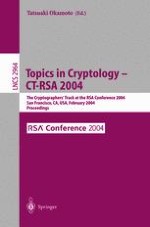The Cryptographers’ Track (CT-RSA) is a research conference within the RSA conference, the largest, regularly staged computer security event. CT-RSA 2004 was the fourth year of the Cryptographers’ Track, and it is now an established venue for presenting practical research results related to cryptography and data security. The conference received 77 submissions, and the program committee sel- ted 28 of these for presentation. The program committee worked very hard to evaluate the papers with respect to quality, originality, and relevance to cryp- graphy. Each paper was reviewed by at least three program committee members. Extended abstracts of the revised versions of these papers are in these proc- dings. The program also included two invited lectures by Dan Boneh and Silvio Micali. I am extremely grateful to the program committee members for their en- mous investment of time and e?ort in the di?cult and delicate process of review and selection. Many of them attended the program committee meeting during the Crypto 2003 conference at the University of California, Santa Barbara.
